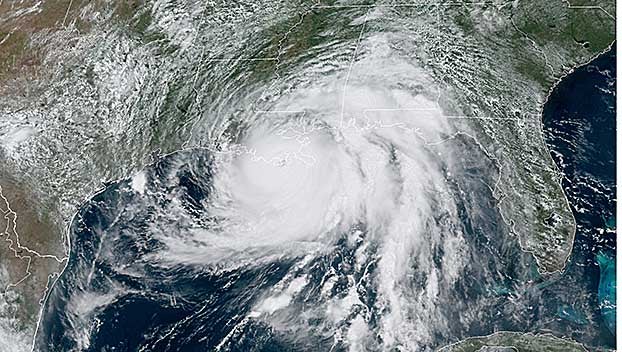Hurricane Ida plows onto Louisiana shore with 150 mph winds, now headed toward southwestern Mississippi
Published 12:08 pm Sunday, August 29, 2021
Hurricane Ida blasted the Louisiana coast on Sunday, with the eye of one of the most powerful storms to ever hit the U.S. coming ashore near the barrier island of Grand Isle with violent winds of 150 mph (241 kph).
Ida’s landfall came on the same date Hurricane Katrina ravaged Louisiana and Mississippi 16 years earlier, about 40 miles (64 kilometers) west of where Category 3 Katrina first struck land.
The storm is expected to move across the southeast Louisiana wetlands, weakening only slightly, and to bring devastating weather to New Orleans and Baton Rouge
Ida rapidly intensified overnight as it moved through some of the warmest ocean water in the world in the northern Gulf of Mexico.
Wind tore at awnings and water began spilling out of Lake Ponchartrain in New Orleans. Officials there said Ida’s swift intensification from a few thunderstorms to massive hurricane over three days left no time to organize a mandatory evacuation of its 390,000 residents.
Mayor LaToya Cantrell urged residents to leave voluntarily. Those who stayed were warned to prepare for long power outages amid sweltering heat.
Nick Mosca was walking his dog, like most of those who were out Sunday morning.
“I’d like to be better prepared. There’s a few things I’m thinking we could have done. But this storm came pretty quick, so you only have the time you have,” Mosca said.
Cars were parked on the median Sunday in New Orleans, which is a few feet higher and can protect against potential flooding. Most businesses were closed, but Breads on Oak, located three blocks from the Mississippi River levee, was open and offering two-for-one deals to get as much of their baked goods sold as possible.
“Everybody’s like, ‘Oooh, we need our hurricane pastries,’” co-owner Chamain O’Mahony said. “So everyone’s coming out for hurricane food — biscuits and a lot of cinnamon rolls and brioche. You want treats. And you want bread.”
Once conditions got too rough or the inventory ran out, O’Mahony and her husband planned to ride out the storm in an apartment they usually rent attached to the bakery.
Ida’s eye was nearing Port Fourchon, where boats and helicopters gather to take workers and supplies to oil platforms in the ocean and the oil extracted starts it journey toward refineries. The port handles about a fifth of the nation’s domestic oil and gas, officials said.
Along with the oil industry, Ida threatened a region already reeling from a resurgence of COVID-19 infections, due to low vaccination rates and the highly contagious delta variant. More than 2 million people live around New Orleans, Baton Rouge and the wetlands to the south.
New Orleans hospitals planned to ride out the storm with their beds nearly full, as similarly stressed hospitals elsewhere had little room for evacuated patients. And shelters for those fleeing their homes carried an added risk of becoming flashpoints for new infections.
Forecasters warned winds stronger than 115 mph (185 kph) were expected soon in Houma, a city of 33,000 that supports oil platforms in the Gulf and Gulfport, Mississippi, to the east of New Orleans was seeing the ocean rise and heavy rains bands.
Gov. John Bel Edwards vowed Louisiana’s “resilient and tough people” would weather the storm.
Edwards said Louisiana officials were working to find hotel rooms for evacuees so that fewer had to stay in mass shelters. He noted that during last year’s hurricane season, Louisiana found rooms for 20,000 people.
President Joe Biden approved emergency declarations for Louisiana and Mississippi ahead of Ida’s arrival.
Comparisons to the Aug. 29, 2005, landfall of Katrina weighed heavily on residents bracing for Ida. A Category 3 storm, Katrina was blamed for 1,800 deaths as it caused levee breaches and catastrophic flooding in New Orleans and demolished oceanfront homes in Mississippi. Ida’s hurricane force winds stretched less than 40 miles (64 kilometers) from the storm’s eye, or less than half the size of Katrina.
Officials stressed that the levee and drainage systems protecting New Orleans had been much improved since Katrina. But they cautioned flooding was still possible, with up to 24 inches (61 centimeters) of rain forecast in some areas.
“Ida will most definitely be stronger than Katrina, and by a pretty big margin,’’ said University of Miami hurricane researcher Brian McNoldy. “And, the worst of the storm will pass over New Orleans and Baton Rouge, which got the weaker side of Katrina.”
Hurricane Ida nearly doubled in strength, going from an 85 mph storm to a 150 mph storm in just 24 hours, which meteorologists called “explosive intensification.”
“Yikes! Ida leaves me stunned,” said Jeff Masters, a former National Oceanic and Atmospheric Administration hurricane hunter meteorologist and founder of Weather Underground.
He warned the region could face devastation to its infrastructure, which includes petrochemical sites and major ports. The state’s 17 oil refineries account for nearly one-fifth of the U.S. refining capacity and its two liquefied natural gas export terminals ship about 55% of the nation’s total exports, according to the U.S. Energy Information Administration. Louisiana is also home to two nuclear power plants, one near New Orleans and another about 27 miles (about 43 kilometers) northwest of Baton Rouge.
The Interstate 10 corridor between New Orleans and Baton Rouge is a critical hub of the nation’s petrochemical industry, lined with oil refineries, natural gas terminals and chemical manufacturing plants. Entergy, Louisiana’s major electricity provider, operates two nuclear power plants along the Mississippi River.
More News






